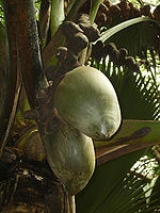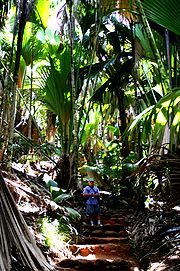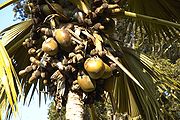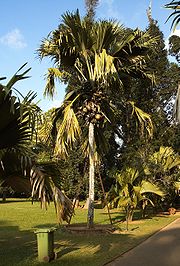
Coco de mer
Encyclopedia
The Coco de Mer the sole member of the genus Lodoicea, is a palm
endemic
to the island
s of Praslin
and Curieuse in the Seychelles
. It formerly also was found on St Pierre, Chauve-Souris and Ile Ronde (Round Island, an islet near Praslin) in the Seychelles group, but has become extinct on these islands. The name of the genus, Lodoicea, is derived from Lodoicus, the Latin
ised form of Louis, in honour of King Louis XV of France
.
 The tree grows to 25–34 m tall. The leaves
The tree grows to 25–34 m tall. The leaves
are fan-shaped, 7–10 m long and 4.5 m wide with a 4 m petiole. It is dioecious
, with separate male and female plants. The male flower
s are catkin
-like, up to 1 m long. The mature fruit
is 40–50 cm in diameter and weighs 15–30 kg, and contains the largest seed
in the plant
kingdom
. The fruit, which requires 6–7 years to mature and a further two years to germinate, is sometimes also referred to as the Sea Coconut, Love Nut, double coconut, coco fesse, or Seychelles Nut.
The Coco de Mer is the most interesting species of the six monospecific endemic palms in Seychelles since it is the "only true case of island gigantism
among Seychelles flowering plants, a unique feature of Seychelles vegetation" (Proctor, 1984). It is one of the most universally well-known plants and holds three botanical records; the largest fruit so far recorded weighed 42 kg; the mature seeds weighing up to 17.6 kg are the world's heaviest; and the female flowers are the largest of any palm.
Of the six endemic palms it is the only dioecious species, with male and female flowers located on different plants.
 Inflorescence
Inflorescence
s are interfoliar, lacking a covering spathe and shorter than the leaves. The staminate inflorescence is catkin-like, one to two metres long and generally terminal and solitary, sometimes two or three catkins may be present. The pistillate inflorescences are also one to two metres long unbranched and the flowers are borne on a zig-zagging rachilla.
 The fruit is bilobed, flattened, 40 to 50 cm long ovoid and pointed, and contains usually one but occasionally two to four seeds. The epicarp is smooth and the mesocarp is fibrous. The endosperm
The fruit is bilobed, flattened, 40 to 50 cm long ovoid and pointed, and contains usually one but occasionally two to four seeds. The epicarp is smooth and the mesocarp is fibrous. The endosperm
is thick, relatively hard, hollow and homogenous. The embryo sits in the sinus between the two lobes. During germination a tubular cotyledon
ary petiole
develops that connects the young plant to the seed. The length of the tube is reported to reach about four metres. In the Vallee de Mai the tube may be up to 10 m long.
The Seychelles nut was once believed to be a sea-bean or drift seed, a seed evolved to be dispersed by the sea. However, it is now known that the viable nut is too dense to float, and only rotted out nuts can be found on the sea surface, thus explaining why the trees are limited in range to just two islands. As stated above, it holds the record for the world's largest seed.
Actually, due to a recent experiment done by students of Christopher Newport University, it was found that the Coco de Mer fruit does indeed float.
 Formerly the Coco de Mer was known as Maldive Coconut. Its scientific name, Lodoicea maldivica, originated before the 18th century when the Seychelles were uninhabited. In centuries past the coconuts that fell from the trees and ended up in the sea would be carried away eastwards by the prevailing sea currents. The nuts can only float after the germination process, when they are hollow. In this way many drifted to the Maldives
Formerly the Coco de Mer was known as Maldive Coconut. Its scientific name, Lodoicea maldivica, originated before the 18th century when the Seychelles were uninhabited. In centuries past the coconuts that fell from the trees and ended up in the sea would be carried away eastwards by the prevailing sea currents. The nuts can only float after the germination process, when they are hollow. In this way many drifted to the Maldives
where they were gathered from the beaches and valued as an important trade and medicinal item.
The unique double coconut closely resembles a woman
's buttocks. This association is reflected in one of the plant's archaic botanical names, Lodoicea callipyge Comm. ex J. St.-Hil., in which callipyge is from Greek words meaning 'beautiful rump'. Other botanical names used in the past include Lodoicea sechellarum Labill. and Lodoicea sonneratii (Giseke) Baill.
Until the true source of the nut was discovered in 1768, it was believed by many to grow on a mythical tree at the bottom of the sea. European nobles in the sixteenth century would often have the shells of these nuts polished and decorated with valuable jewels as collectibles for their private galleries. The Coco de Mer tree is now a rare and protected species.
and Silhouette Island
s in the Seychelles to help conserve the species. The fruit is used in Ayurvedic medicine and also in traditional Chinese medicine
.
Arecaceae
Arecaceae or Palmae , are a family of flowering plants, the only family in the monocot order Arecales. There are roughly 202 currently known genera with around 2600 species, most of which are restricted to tropical, subtropical, and warm temperate climates...
endemic
Endemic (ecology)
Endemism is the ecological state of being unique to a defined geographic location, such as an island, nation or other defined zone, or habitat type; organisms that are indigenous to a place are not endemic to it if they are also found elsewhere. For example, all species of lemur are endemic to the...
to the island
Island
An island or isle is any piece of sub-continental land that is surrounded by water. Very small islands such as emergent land features on atolls can be called islets, cays or keys. An island in a river or lake may be called an eyot , or holm...
s of Praslin
Praslin
Praslin is the second largest island of the Seychelles, lying 44 km north east of Mahé. Praslin has a population of around 6,500 people and comprises two administrative districts; Baie Sainte Anne and Grand' Anse . The main settlements are the Baie Ste Anne, Anse Volbert and Grand' Anse.It was...
and Curieuse in the Seychelles
Seychelles
Seychelles , officially the Republic of Seychelles , is an island country spanning an archipelago of 115 islands in the Indian Ocean, some east of mainland Africa, northeast of the island of Madagascar....
. It formerly also was found on St Pierre, Chauve-Souris and Ile Ronde (Round Island, an islet near Praslin) in the Seychelles group, but has become extinct on these islands. The name of the genus, Lodoicea, is derived from Lodoicus, the Latin
Latin
Latin is an Italic language originally spoken in Latium and Ancient Rome. It, along with most European languages, is a descendant of the ancient Proto-Indo-European language. Although it is considered a dead language, a number of scholars and members of the Christian clergy speak it fluently, and...
ised form of Louis, in honour of King Louis XV of France
Louis XV of France
Louis XV was a Bourbon monarch who ruled as King of France and of Navarre from 1 September 1715 until his death. He succeeded his great-grandfather at the age of five, his first cousin Philippe II, Duke of Orléans, served as Regent of the kingdom until Louis's majority in 1723...
.
Description

Leaf
A leaf is an organ of a vascular plant, as defined in botanical terms, and in particular in plant morphology. Foliage is a mass noun that refers to leaves as a feature of plants....
are fan-shaped, 7–10 m long and 4.5 m wide with a 4 m petiole. It is dioecious
Plant sexuality
Plant sexuality covers the wide variety of sexual reproduction systems found across the plant kingdom. This article describes morphological aspects of sexual reproduction of plants....
, with separate male and female plants. The male flower
Flower
A flower, sometimes known as a bloom or blossom, is the reproductive structure found in flowering plants . The biological function of a flower is to effect reproduction, usually by providing a mechanism for the union of sperm with eggs...
s are catkin
Catkin
A catkin or ament is a slim, cylindrical flower cluster, with inconspicuous or no petals, usually wind-pollinated but sometimes insect pollinated . They contain many, usually unisexual flowers, arranged closely along a central stem which is often drooping...
-like, up to 1 m long. The mature fruit
Fruit
In broad terms, a fruit is a structure of a plant that contains its seeds.The term has different meanings dependent on context. In non-technical usage, such as food preparation, fruit normally means the fleshy seed-associated structures of certain plants that are sweet and edible in the raw state,...
is 40–50 cm in diameter and weighs 15–30 kg, and contains the largest seed
Seed
A seed is a small embryonic plant enclosed in a covering called the seed coat, usually with some stored food. It is the product of the ripened ovule of gymnosperm and angiosperm plants which occurs after fertilization and some growth within the mother plant...
in the plant
Plant
Plants are living organisms belonging to the kingdom Plantae. Precise definitions of the kingdom vary, but as the term is used here, plants include familiar organisms such as trees, flowers, herbs, bushes, grasses, vines, ferns, mosses, and green algae. The group is also called green plants or...
kingdom
Kingdom (biology)
In biology, kingdom is a taxonomic rank, which is either the highest rank or in the more recent three-domain system, the rank below domain. Kingdoms are divided into smaller groups called phyla or divisions in botany...
. The fruit, which requires 6–7 years to mature and a further two years to germinate, is sometimes also referred to as the Sea Coconut, Love Nut, double coconut, coco fesse, or Seychelles Nut.
The Coco de Mer is the most interesting species of the six monospecific endemic palms in Seychelles since it is the "only true case of island gigantism
Island gigantism
Island gigantism or insular giantism is a biological phenomenon in which the size of animals isolated on an island increases dramatically in comparison to their mainland relatives....
among Seychelles flowering plants, a unique feature of Seychelles vegetation" (Proctor, 1984). It is one of the most universally well-known plants and holds three botanical records; the largest fruit so far recorded weighed 42 kg; the mature seeds weighing up to 17.6 kg are the world's heaviest; and the female flowers are the largest of any palm.
Of the six endemic palms it is the only dioecious species, with male and female flowers located on different plants.
Habit
The Coco de Mer palm is robust, solitary, up to 30 m tall with an erect, spineless, stem which is ringed with leaf scars (Calstrom, unpublished). The base of the trunk is of a bulbous form and this bulb fits into a natural bowl, or socket, about 2.5 ft in diameter and 18 inches in depth, narrowing towards the bottom. This bowl is pierced with hundreds of small oval holes about the size of a thimble with hollow tubes corresponding on the outside through which the roots penetrate the ground on all sides, never, however, becoming attached to the bowl; they are partially elastic, affording an almost imperceptible but very necessary "play" to the parent stem when struggling against the force of violent gales.Leaves
The crown is a rather dense head of foliage with leaves that are stiff, palmate up to 10 m in diameter and petioles of two to four metres in length. The leaf is plicate at the base, cut one third or more into segments 4–10 cm broad with bifid end which are often drooping. A triangular cleft develops at the petiole base.Flowers
The clusters of staminate flowers are arranged spirally and are flanked by very tough leathery bracts. Each has a small bracteole, three sepals forming a cylindrical tube, and a three-lobed corolla. There are 17 to 22 stamens. The pistillate flowers are solitary and borne at the angles of the rachis and are partially sunken in it in the form of a cup. They are ovoid with three petals as well as three sepals. It has been suggested that they may be pollinated by animals such as the endemic lizards which inhabit the forest where they occur. Pollination by wind and rain are also thought to be important. Only when Locoicea begins to produce flowers, which can vary from 11 years to 45 or more, is it possible to determine the sex of the plant.Inflorescence

Inflorescence
An inflorescence is a group or cluster of flowers arranged on a stem that is composed of a main branch or a complicated arrangement of branches. Strictly, it is the part of the shoot of seed plants where flowers are formed and which is accordingly modified...
s are interfoliar, lacking a covering spathe and shorter than the leaves. The staminate inflorescence is catkin-like, one to two metres long and generally terminal and solitary, sometimes two or three catkins may be present. The pistillate inflorescences are also one to two metres long unbranched and the flowers are borne on a zig-zagging rachilla.
Fruit

Endosperm
Endosperm is the tissue produced inside the seeds of most flowering plants around the time of fertilization. It surrounds the embryo and provides nutrition in the form of starch, though it can also contain oils and protein. This makes endosperm an important source of nutrition in human diet...
is thick, relatively hard, hollow and homogenous. The embryo sits in the sinus between the two lobes. During germination a tubular cotyledon
Cotyledon
A cotyledon , is a significant part of the embryo within the seed of a plant. Upon germination, the cotyledon may become the embryonic first leaves of a seedling. The number of cotyledons present is one characteristic used by botanists to classify the flowering plants...
ary petiole
Petiole
Petiole may refer to:*Petiole , the stalk of a leaf, attaching the blade to the stem*Petiole , the stem formed by a restricted abdominal segment that connects the thorax with the gaster in the suborder Apocrita...
develops that connects the young plant to the seed. The length of the tube is reported to reach about four metres. In the Vallee de Mai the tube may be up to 10 m long.
The Seychelles nut was once believed to be a sea-bean or drift seed, a seed evolved to be dispersed by the sea. However, it is now known that the viable nut is too dense to float, and only rotted out nuts can be found on the sea surface, thus explaining why the trees are limited in range to just two islands. As stated above, it holds the record for the world's largest seed.
Actually, due to a recent experiment done by students of Christopher Newport University, it was found that the Coco de Mer fruit does indeed float.
Habitat
Coco de Mer trees inhabit rainforests where there are deep, well-drained soils and open exposed slopes; although growth is reduced on such eroded soils.History and mythology

Maldives
The Maldives , , officially Republic of Maldives , also referred to as the Maldive Islands, is an island nation in the Indian Ocean formed by a double chain of twenty-six atolls oriented north-south off India's Lakshadweep islands, between Minicoy Island and...
where they were gathered from the beaches and valued as an important trade and medicinal item.
The unique double coconut closely resembles a woman
Woman
A woman , pl: women is a female human. The term woman is usually reserved for an adult, with the term girl being the usual term for a female child or adolescent...
's buttocks. This association is reflected in one of the plant's archaic botanical names, Lodoicea callipyge Comm. ex J. St.-Hil., in which callipyge is from Greek words meaning 'beautiful rump'. Other botanical names used in the past include Lodoicea sechellarum Labill. and Lodoicea sonneratii (Giseke) Baill.
Henri Ernest Baillon
Henri Ernest Baillon was a French botanist and physician. He was born in Calais on November 30, 1827 and died in Paris on July 19, 1895.Baillon spent his professional life as a professor of natural history, and he published numerous works on botany...
Until the true source of the nut was discovered in 1768, it was believed by many to grow on a mythical tree at the bottom of the sea. European nobles in the sixteenth century would often have the shells of these nuts polished and decorated with valuable jewels as collectibles for their private galleries. The Coco de Mer tree is now a rare and protected species.
Uses
The species is grown as an ornamental tree in many areas in the tropics, and subsidiary populations have been established on MahéMahé, Seychelles
Mahé is the largest island of the Seychelles, lying in the north east of the nation. The population of Mahé is 80,000. It contains the capital city of Victoria and accommodates 90% of the country's total population...
and Silhouette Island
Silhouette Island
Silhouette Island lies 20 km northwest of Mahé in the Seychelles. It is the third largest island in the Seychelles. It has an area of 20 km² and has a population of 135, mostly workers on the island. The main settlement is La Passe, where there is a hotel for visitors to Silhouette...
s in the Seychelles to help conserve the species. The fruit is used in Ayurvedic medicine and also in traditional Chinese medicine
Traditional Chinese medicine
Traditional Chinese Medicine refers to a broad range of medicine practices sharing common theoretical concepts which have been developed in China and are based on a tradition of more than 2,000 years, including various forms of herbal medicine, acupuncture, massage , exercise , and dietary therapy...
.

